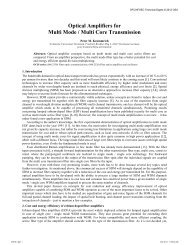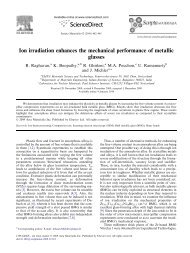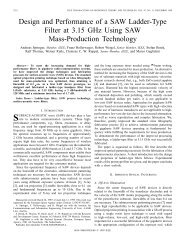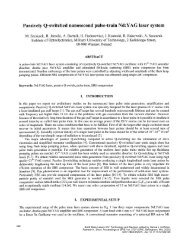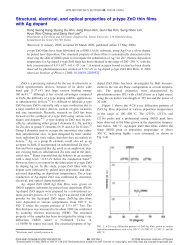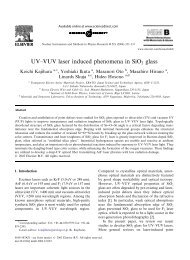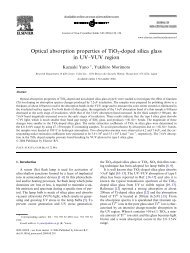Variant selection of primary, secondary and tertiary twins in a ...
Variant selection of primary, secondary and tertiary twins in a ...
Variant selection of primary, secondary and tertiary twins in a ...
Create successful ePaper yourself
Turn your PDF publications into a flip-book with our unique Google optimized e-Paper software.
2050 S. Mu et al. / Acta Materialia 60 (2012) 2043–2053<br />
4.2. Does the accommodation stra<strong>in</strong> control the growth <strong>of</strong> the<br />
<strong>primary</strong> extension <strong>tw<strong>in</strong>s</strong>?<br />
Dur<strong>in</strong>g <strong>primary</strong> extension tw<strong>in</strong>n<strong>in</strong>g, three different variants<br />
were nucleated <strong>and</strong> grew. The orientations <strong>and</strong> SFs <strong>of</strong><br />
all the possible ETW variants <strong>of</strong> matrix a were calculated.<br />
We deduced that the tw<strong>in</strong> variants correspond<strong>in</strong>g to<br />
observed orientations b, d <strong>and</strong> c were at2, at5 <strong>and</strong> at6,<br />
respectively. The SFs <strong>of</strong> the selected variants were all relatively<br />
high, especially for at2 (b) <strong>and</strong> at5 (d) with SFs <strong>of</strong><br />
0.404 <strong>and</strong> 0.392, respectively. However, variant b grew to<br />
a considerably greater extent than the other two. Thus<br />
although nucleation appeared to be <strong>in</strong>fluenced by the SF,<br />
the latter cannot properly account for the different growth<br />
capabilities displayed by <strong>tw<strong>in</strong>s</strong> <strong>of</strong> similar SF.<br />
In Mg alloys, once ETWs are nucleated, they grow cont<strong>in</strong>uously<br />
dur<strong>in</strong>g stra<strong>in</strong><strong>in</strong>g <strong>and</strong> gradually replace the<br />
matrix. In the present case, the tw<strong>in</strong> with the greatest ease<br />
<strong>of</strong> growth consumed its parent gra<strong>in</strong> almost completely <strong>and</strong><br />
thus essentially contacted all the adjacent gra<strong>in</strong>s. Once a<br />
tw<strong>in</strong> reaches a gra<strong>in</strong> boundary, the immediate region <strong>of</strong><br />
the adjo<strong>in</strong><strong>in</strong>g gra<strong>in</strong> is sheared <strong>and</strong> stress concentrations<br />
are accumulated at the boundary. These stress concentrations<br />
are relaxed by slip <strong>and</strong> tw<strong>in</strong>n<strong>in</strong>g <strong>in</strong> the neighbor<strong>in</strong>g<br />
gra<strong>in</strong>, produc<strong>in</strong>g what are known as the accommodation<br />
stra<strong>in</strong>s. By rotat<strong>in</strong>g the tw<strong>in</strong>n<strong>in</strong>g shear displacement gradient<br />
tensor from the tw<strong>in</strong> system frame <strong>in</strong>to the crystal<br />
frame <strong>of</strong> the neighbor<strong>in</strong>g gra<strong>in</strong>, the nature <strong>of</strong> the accommodation<br />
stra<strong>in</strong> that the ETW is try<strong>in</strong>g to impose on the<br />
neighbor<strong>in</strong>g gra<strong>in</strong> can be determ<strong>in</strong>ed. When the growth<br />
<strong>of</strong> a particular ETW variant requires the operation <strong>of</strong> a<br />
“difficult” deformation mechanism such as prismatic slip<br />
<strong>in</strong> the adjacent gra<strong>in</strong>, high back-stresses are generated<br />
<strong>and</strong> such growth is h<strong>in</strong>dered. S<strong>in</strong>ce the prismatic glide<br />
stra<strong>in</strong> components e xy <strong>and</strong> e yx are classified as “difficult”,<br />
<strong>in</strong> the follow<strong>in</strong>g, only these components will be considered<br />
to govern tw<strong>in</strong> variant <strong>selection</strong>.<br />
At e = 0.11, <strong>primary</strong> ETW b had already almost completely<br />
consumed its parent gra<strong>in</strong> <strong>and</strong> contacted most <strong>of</strong> the<br />
neighbor<strong>in</strong>g gra<strong>in</strong>s. The accommodation stra<strong>in</strong> tensors <strong>of</strong><br />
all six matrix a tw<strong>in</strong> variants <strong>in</strong> all the adjacent gra<strong>in</strong>s were<br />
therefore calculated. However, s<strong>in</strong>ce the growth competition<br />
only concerned the three selected ETWs at2, at5 <strong>and</strong><br />
at6, only the values for these are plotted <strong>in</strong> Fig. 5. Ase xy<br />
is one <strong>of</strong> the “difficult” stra<strong>in</strong> components, <strong>in</strong> Fig. 5, the values<br />
<strong>of</strong> e xy /e xy (m<strong>in</strong>) are plotted for neighbor<strong>in</strong>g gra<strong>in</strong>s I–XI<br />
(Fig. 5a), where e xy (m<strong>in</strong>) is the lowest e xy imposed by one<br />
<strong>of</strong> the six tw<strong>in</strong> variants on the neighbor<strong>in</strong>g gra<strong>in</strong> be<strong>in</strong>g<br />
considered.<br />
For ease <strong>of</strong> comparison, the data <strong>of</strong> Fig. 5a are<br />
regrouped <strong>and</strong> replotted <strong>in</strong> Fig. 5b, where the values are<br />
collected for each <strong>of</strong> the variants. 1 It is clear that variant<br />
1 In some <strong>of</strong> the neighbor<strong>in</strong>g gra<strong>in</strong>s, two orientations obey<strong>in</strong>g an ETW<br />
relationship were detected. Both orientations were considered as adjacent<br />
gra<strong>in</strong>s, although only the lower value <strong>of</strong> e xy was used for plott<strong>in</strong>g<br />
purposes.<br />
Fig. 5. (a) Accommodation stra<strong>in</strong>s e xy /e xy (m<strong>in</strong>) that three <strong>of</strong> the <strong>primary</strong><br />
extension <strong>tw<strong>in</strong>s</strong> (at2, at5 <strong>and</strong> at6) are try<strong>in</strong>g to impose on neighbor<strong>in</strong>g<br />
gra<strong>in</strong>s I–IX; (b) the values <strong>of</strong> e xy /e xy (m<strong>in</strong>) are collected for each <strong>of</strong> the tw<strong>in</strong><br />
variants (at2, at5 <strong>and</strong> at6). Here e xy (m<strong>in</strong>) is the smallest e xy be<strong>in</strong>g imposed<br />
by one <strong>of</strong> the six variants on the adjacent gra<strong>in</strong>.<br />
at2 (b) requires the lowest e xy <strong>in</strong> all the neighbor<strong>in</strong>g gra<strong>in</strong>s<br />
(except for IX), whereas variants at5 (d) <strong>and</strong> at6 (c) require<br />
much larger amounts <strong>of</strong> the “difficult” e xy stra<strong>in</strong> (as much<br />
as 10–100 times more, which is not evident due to the curtailment<br />
<strong>of</strong> the y-axis). Tw<strong>in</strong> variant at6, which corresponds<br />
to tw<strong>in</strong> orientation c, displays relatively low e xy /<br />
e xy (m<strong>in</strong>) values with respect to its adjo<strong>in</strong><strong>in</strong>g gra<strong>in</strong>s, i.e.<br />
gra<strong>in</strong>s VI–IX, as shown <strong>in</strong> Fig. 5b. By contrast, tw<strong>in</strong> variant<br />
at5 (d), which had a higher SF (0.392) than at6 (0.323),<br />
nevertheless did not grow, an observation that can be readily<br />
expla<strong>in</strong>ed by its relatively high values <strong>of</strong> e xy <strong>in</strong> most <strong>of</strong><br />
the neighbor<strong>in</strong>g gra<strong>in</strong>s (see the second set <strong>of</strong> columns <strong>in</strong><br />
Fig. 5b). The values <strong>of</strong> e xy + e yx were also calculated for<br />
the three variants. These led to similar conclusions <strong>and</strong><br />
are not presented here.<br />
4.3. Does the accommodation stra<strong>in</strong> control the nucleation <strong>of</strong><br />
the <strong>secondary</strong> contraction <strong>tw<strong>in</strong>s</strong>?<br />
In this section we test the validity <strong>of</strong> the accommodation<br />
stra<strong>in</strong> hypothesis by apply<strong>in</strong>g it to the <strong>selection</strong> <strong>of</strong> the <strong>secondary</strong><br />
CTW variants. As shown <strong>in</strong> the EBSD map <strong>of</strong><br />
Fig. 3a, two sets <strong>of</strong> <strong>secondary</strong> CTWs e <strong>and</strong> g, as well as<br />
two sets <strong>of</strong> <strong>tertiary</strong> ETWs f <strong>and</strong> h were detected. It was concluded<br />
above that CTWs e <strong>and</strong> g were the matrices for <strong>tertiary</strong><br />
<strong>tw<strong>in</strong>s</strong> f <strong>and</strong> h, respectively. Therefore, when we<br />
consider the gra<strong>in</strong>s adjacent to the <strong>secondary</strong> CTWs, the<br />
ones <strong>in</strong> contact with the <strong>tertiary</strong> <strong>tw<strong>in</strong>s</strong> should also be taken<br />
<strong>in</strong>to account (as these were formerly neighbor<strong>in</strong>g gra<strong>in</strong>s <strong>of</strong>




